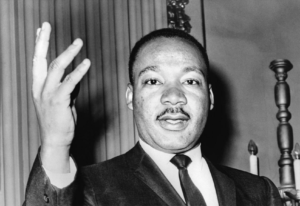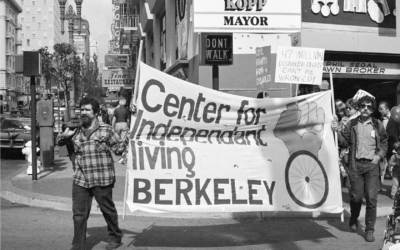
Photo by Wikimedia Commons
Civil and social rights for many people in America have been hard sought at great sacrifice. An exploration of history reveals a harrowing history for Black Americans and people with disabilities alike. Martin Luther King, Jr., along with other key individuals, championed equal rights, ultimately leading to the Civil Rights Act of 1964 and the Voting Rights Act of 1965. This increased inclusion and reduced the outright marginalization of Black Americans. Sadly, in 1968 Martin Luther King, Jr. was assassinated. This was the same year as John F. Kennedy Jr. and Malcolm X. All three of these champions of liberty met an untimely death while speaking out for social change in society.
During the marches and the protests of the ‘60s, people with disabilities marched alongside Black Americans and others in support of equality while also carrying their own torch called the Independent Living Movement. This movement is a philosophy that essentially involves full participation, self-reliance, independence, and social inclusion for people with disabilities in all of society.
Section 504
While the Civil Rights Act was passed in 1964, preventing labor discrimination based on race, religion, gender, or nationality, it wasn’t until 1972-73 that Section 504 of the Rehabilitation Act was drafted. This was the first significant piece of modern legislation concerning people with disabilities. Section 504 was the first American civil rights law offering some protection from discrimination against people with disabilities by stating that no one could be denied federal funds on the basis of (dis)ability, whereas previously they were. It also established people with disabilities as a minority class which finally brought a cohesive voice to people with disabilities, despite the unfortunate nature of being considered a minority because of ability. Prior to this, individuals, and individual diagnoses and circumstances were dealt with on a case-by-case basis, usually not with favorable outcomes.
 However, while Section 504 was written in 1972-73, once the implications of potential costs and added rights for people with disabilities became clear, the Nixon and Ford administrations attempted to rewrite the language and not pass the law. Protests and sit-ins by people with disabilities including historical moments on Madison Avenue and in Washington DC. A lawsuit was filed in 1975 that pressured the office of Heath, Education, and Welfare to sign the law.
However, while Section 504 was written in 1972-73, once the implications of potential costs and added rights for people with disabilities became clear, the Nixon and Ford administrations attempted to rewrite the language and not pass the law. Protests and sit-ins by people with disabilities including historical moments on Madison Avenue and in Washington DC. A lawsuit was filed in 1975 that pressured the office of Heath, Education, and Welfare to sign the law.
Incoming President Jimmy Carter promised to endorse the legislation. But he, too, grew cautious and at the last minute made an effort to change the law’s language from considering people with disabilities as fully integrated into society to “separate but equal.” News of this pending change leaked. This resulted in the now-famous sit-in in San Francisco that lasted 25 days and remains the longest non-violent occupation of a federal building in U.S. history. As the story is told, the Black Panthers supported the sit-in by bringing food to the protesters.
A Dream Made Real
In 1977, five years after draft legislation, 13 years following the Civil Rights Act, and after overcoming efforts by many, including three presidential administrations, to revise or sabotage it, Section 504 was finally signed. Even so, the struggle for rights for people with disabilities continued for another 13 years. It wasn’t until 1990 that the Americans with Disabilities Act (ADA) was signed by George Bush, Sr. (Stay tuned for a more detailed discussion of the ADA during its anniversary month in July).
Without the pioneering, humble, peaceful warriorship of Martin Luther King, Jr., it’s hard to imagine where rights for people with disabilities would be today. Had the fight for Civil Rights failed, it’s possible we could be living in a different world, one perhaps dominated by institutionalization and categorical marginalization and discrimination. In many countries around the world, people with disabilities face this fate. We are grateful for the changes in our laws and culture that have been good first steps toward equality, and we continue to work proactively to reduce remaining discrimination and increase inclusion, equity, and accessibility.
Today, we offer great thanks and appreciation, and sincere honor and reverence to Martin Luther King, Jr. for his culture-changing work that led to Civil Rights and paved the way for disability rights.
Want to be updated via our newsletter? Sign up below!
Stay Connected





